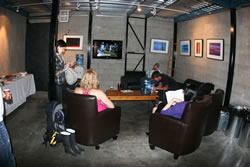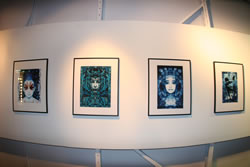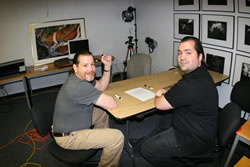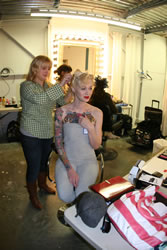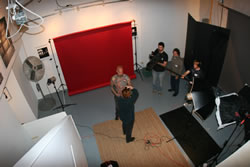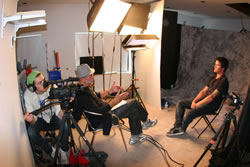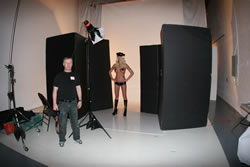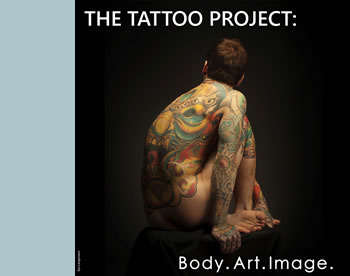HOME
TATTOO BLOG
SYMBOLS & DESIGNS
CELEBRITY TATTOOS
THE TATTOO PROJECT
TATTOO PHOTOS
TATTOO MUSEUM
TRIBAL TATTOOS
TATTOO FACTS
TATTOO LINKS
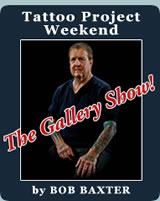
The Tattoo Project Weekend
Planning, coordinating and pulling off something as complex, emotionally taxing and thoroughly frustrating as assigning a dozen different photographers to photograph each of nearly one hundred tattoo models can be, as Vince himself said, “Like herding a bunch of cats.” Well, meow, because Mr. Hemingson, as Paul McCartney said in song, “Did it and he did it good.” (McCartney was talking about having sex with his wife, which has nothing to do with Vince, but you get the idea.) I arrived at the Vancouver Photo Workshops at 14 West 7th on a Friday. This was the day to reconnoiter, have meetings, discover where the bathroom is and talk about the next three days. The workshop itself is enormous, with two floors (plus a basement) divided up into various white-walled photo studios, cubbyholes, offices, hallways and storage rooms. The main, grand ballroom, if you will, is divided into two sections with infinitely high ceilings, countless light stands, multiple reflectors, miles of electrical cable and, in the main venues, some rather magnificent Chinese balls. For the uninitiated, a Chinese ball is, well, a ball (about the size of one of those round exercise ball thingies) with a light inside. It’s a diffuser, okay? So, there you have it, white walls, hallways lined with photographs (several from the artists involved in the project), a lounge area with comfy sofas and a lovely breakfast. Around noon time, a magnificent spread of fresh fruit, pizza, salads, chicken wings, coffee, tea, soft drinks and bottled water replaced the muffins and jam. Nothing worse than sitting around to have your photo snapped and your stomach is growling. No problem with that here. Well done. I might point out that the Workshop, which is home to an elaborate schedule of classes, seminars and private lessons teaching photography via a solid roster of local and visiting professionals, is the brainchild of Marc Koegel, the Director (www.silverlandscapes.com). What with the number of people involved, the scheduling of countless photos sessions and the enormity of the end goal of this far-reaching project (Hemingson plans to create a television special, a gallery show, a calendar, a number of coffee table books and help fund several charitable foundations—most notably ones that address the specific needs of Aboriginal and First Nations people), it would be acceptable to skip over certain details, like creature comforts, the taming of clashing personalities (especially the photographers’) and the missing of certain, less pressing opportunities. None of that happened here. There was plenty to eat, an excellent lounge area, lots of electrical outlets, clean restrooms and plenty of helpful people. In all, Hemingson and Koegel designed and carried out a seamless weekend. I heard nary a complaint or strident word. Photographers can often be a surly bunch, but there was no evidence of short fuses, temper tantrums or slugfests.
The plan was simple: every available tattoo shop, music venue, aficionado list and website was notified by email, flyer, phone call or personal visit to recruit appropriate tattooed models of both sexes for the festivities. One of the models was even flown in from New York City. And I am sure that others travelled great distances, when they heard about this exciting project. I came all the way from Hood River, Oregon, for example. The photographers were pretty much on site most of the time, but the models themselves were given specific time slots throughout the day. Each model was photographed by each of the photographers in different ways. In other words, one photographer was responsible for mug shots and close-ups of the person’s tattoos. Another photographed models as art objects, still lives, if you will. A third shot with an eye to extensive Photoshop manipulating, so his images would look more like intricate, computerized graphics than photographs, per se. Each model and each photographer was also interviewed on video tape by “P.J.” Reece, who, along with Hemingson (and myself, at times), asked pertinent questions regarding the tattoos, why the models chose them, what they meant and how they might have affected the wearer’s life. The director of this segment, Jack Silberman, was also a key participant in Hemingson’s other video projects, including the award-winning Vanishing Tattoo film, which was aired on the National Geographic Channel. The director of photography was Oliver Millar, the second cameraman was Clif Prowse and the soundman was Grady Lawlor. Videotaping is an exhausting assignment, yet everyone on the crew seemed enthusiastic all the day long. I have worked with many video and film crew’s myself and am always am impressed by their positive attitude and boundless energy. For example, standing around, holding a boom mike all day long would make me crazy. Grady not only did it without a hitch, he was having a terrific time doing it. My hat is off to this covey of talented professionals.
In the tattoo magazine business, there is a lot of competition among the top half dozen lenspeople, so there are a lot of clashing egos and a slew of horror stories (one famous photographer, when asked by a pretty female model if she might be on the cover of a certain tattoo magazine, responded, “Honey, loose fifteen pounds and I might consider it.” Yikes!). At the Vancouver Workshop gig, there didn’t seem to be any of that. The photographers were polite, patient and supportive. Pooya Nabei, for instance (he is primarily a fashion photographer) must have said the word “perfect” a hundred and fifty times, while he was shooting me. Very encouraging, especially when one is slightly uncomfortable with having their photo taken. If I remember correctly, the photographers, Johnathon Strebly (www.epixstudios.com), Syx Langeman who also designed the poster for the project (www.blackframesstudios.ca), Jeff Weddell (www.jeffweddell.com), Roz Norbury (www.rosamondnorbury.com), Dan Kozma (www.kozphotography.com), Spencer Kovats (www.spencerkovats.com), Aura McKay (www.auramckay.com), Wayne A. Höecherl (www.ordeal.ca), Melanie Jane (www.sugarcreative.ca), Marc Koegel (www.marckoegel.com) and, of course, Vince Hemingson (www.hemingsonphotography.com), all used 35mm digital cameras. Lots of Canons, if I recall. Some used color backdrops, some used the white walls. Some painted their subjects with mottled light, others opted for an even, overall tone, but the one thing I noticed was the intent of their camera work. For a tattoo magazine, what with the great number of potential people to shoot at a tattoo convention, for example, fifteen minutes per person is about standard. The lights are already positioned and the photographer usually knows what he or she wants. Some photographers take a couple thousand shots a weekend, because there are so many people. With my magazine, we did more editing in the camera, and shooting forty people over two days was a lot. But then, we only photographed those who we were pretty sure would go into the magazine. At the Vancouver Workshop shoot, the great majority of the photographers did not specialize in shooting tattooed people and some had never really tried it before, so they tended to light, pose the models and shoot in an exploratory way. Hemingson told me that he was attempting to photograph the models like they were statuary. In fact, when he sent me a sample of a photo he did of me, he referred to the image as looking like I was a Roman Senator. I consider that a compliment. Dominus vobiscum.
—Bob Baxter As editor in chief of Skin&Ink magazine for over fourteen years, Bob Baxter guided the publication to a Folio Magazine Editorial Excellence Award, making it America’s most respected and educational body art publication. He currently edits and writes a Daily Blog at www.tattooroadtrip.com, the ultimate E-zine and resource site for international tattoo artists and collectors. He also has his Tattoo Chronicles series and the 101 Most Influential People in Tattooing right here @ Vanishing Tattoo. To ask questions, make comments or demand an apology, you can email Bob at baxter@tattooroadtrip.com. |
|
 By Bob Baxter
By Bob Baxter 
